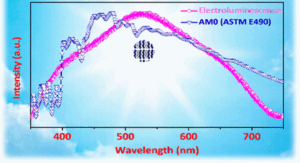[White LEDs (WLED) are a major part of many displays, especially LCD displays. No current white LEDs emit white light directly – they use GaN blue LEDs and use phosphors, quantum dots or some other material to down-convert some of the blue photons to red and green photons. This approach is also commonly used for WLEDs used in general illumination applications.

An alternative approach to white light is to use three discrete LEDs, blue, green and red, to generate the desired white light. This approach has been used in some high-end LCD TV sets and in most LED-based projectors.
A team of six researchers at National Tsing Hua University, Academia Sinica and National Taiwan University has shown an approach to WLEDs where white light is emitted directly from a single LED, no photon down-conversion required.
The new WLED LED consists of three layered components:
- A strontium-based metal–organic framework (MOF), {[Sr(ntca)(H2O)2]·H2O}n,
- Graphene and
- Inorganic semiconductors (i.e. Silicon).
This layered structure, shown in the image, can generate a bright white light emission. The lowest layer is a p-Si substrate with a SiO2 insulating layer. This is topped by Silver (Ag) and Zinc Oxide (ZnO) layers and then the MOF structure. The graphene and PMMA top layers serve as the top electrode and transparent window.
 Layered Structure of the MOF WLED System
Layered Structure of the MOF WLED System
The current approaches, wavelength conversion or multiple LEDs have a serious disadvantage, especially when used in general illumination applications: they tend to have a relatively low Color Rendering Index (CRI) This is due to the fact that these approaches emit light in discrete bands. In wavelength conversion systems, it is normally two bands – blue from the GaN LED and yellow from the wavelength conversion. Red and/or green phosphors or QDs can be added to broaden the yellow band, increasing the CRI, but the band structure normally remains. In three-LED systems, there are three bands, blue, green, and red. In some CRI-sensitive applications such as studio lighting, more than three different LEDs are used to increase CRI by filling the gaps between the blue, green and red LED spectra. This multi-LED approach can also be taken in multi-primary color (MPC) projectors to increase the color gamut.
The new material has a continuous spectrum closely resembling the sunlight spectrum with a CCT (correlated color temperature) of 5451 K, producing a natural white light. While the CRI is not given, from the spectrum I would say it should have a value very close to 100%, indicating all colors are rendered correctly. The electroluminescence of this MOF layered WLED is shown in the image. It is compared to a standard solar spectrum defined by ASTM E490.
olSpectral Emission of the MOF WLED System
Another disadvantage of phosphor conversion WLEDs is that the phosphors normally contain rare earth elements. Since most rare earths come from China (The PRC, not Taiwan), the supply is subject to disruption for political reasons. This is not just a theoretical problem – China has disrupted the supply rare earth materials in the past.
An article in the American Chemical Society journal ACS Nano (doi:10.1021/acsnano.6b03030) and a previous publication in the Royal Society of Chemistry Journal of Materials Chemistry C (DOI:10.1039/C6TC00839A) doesn’t mean this material is about to enter production for use in general lighting or LCD displays. The authors of this research paper say “Because electroluminescence using a MOF as an active material is very rare and intriguing and a direct WLED is also not commonly seen, our work here therefore represents a major discovery which should be very useful and timely for the development of solid-state lighting.” If lighting is “timely,” can LCD illumination be far behind? For that matter, if the MOF layer proves relatively easy to make on large area substrates, would patterning the graphene, silver and p-Si layers lead to large-area emissive displays to compete with OLEDs? Time will tell. –Matthew Brennesholtz

